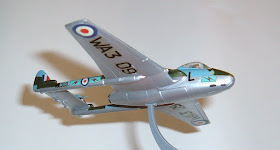I'm taking a break in my usual lineup of kits I built as a kid, to show you one I
wished I had as a kid. The Nichimo 1/20th scale Hughes 500 helicopter was one of those untouchable model kits displayed behind the counter at Peterson Hobbies. I knew I could never afford it, and that it would probably be too complex for me to build. Thirty-five years later however, the opportunity finally came to procure one of these highly collectible action model kits.
These appear rather frequently on EBay, but for outrageous starting bid prices. In the case of this one shown here, patience payed off when I spotted it complete, but in a tattered box. The seller claimed all the pieces were included, so I took a chance and bid on it. To my surprise I won it for a much lower price than these usually sell for. The box was indeed in bad shape, but I wasn't getting this kit for the box!

This is an awesome model; extremely fun and challenging to build, especially if one chooses the motorized version because there are lots of gear boxes and wires to assemble. There's even a working miniature light bulb for the landing light! The interior is stunningly detailed, with everything from pilot's headsets, magazine pockets in the forward bulkhead, fire extinguisher, first aid kit, vinyl strapping material for the seat belts, and wire tubing for the turbine engine. If you choose to go with the display only version, you can mount the assembled engine into the fuselage and view it through an opening access cover. But the neat thing about going motorized is you can still build the highly detailed engine and display it externally on its transport dolly.
There's a lot of anticipation of the finished working product when assembling this model. There are many steps to completing the motorized workings, and no opportunity to test the thing out until you finally mount the chopper to the control platform. Then, and only then, with a push of a button, the kit comes alive with rotating blades. It's really quite amazing to see the thing work after all the labor involved.

There is a full color painting guide showing five versions, but the decal sheet only includes full body panel markings for one version - the American one. I chose to do the Japanese Kawasaki version, but that meant painting the decorative panels on the fuselage, tail boom, and fins. What a pain that was! I used Tamiya gloss blue, but there was a lot of bleeding through the masking tape that had to be painstakingly corrected afterwards. The original decals were barely usable, not wanting to come off the backing sheet. I had to coat them with clear gloss when they dried to ensure adhesion.
This is a really fun model to have on my office shelf, and goes to show one is never too old to have something dreamed of since childhood.

 In rebuilding this kit, I discovered why the kit shown on the box top differs from the kit inside. Apparently Hawk's original TV-2 kit from 1959 (shown left) had the correct early Navy version illustrated on the box, which jived with the decals and instructions. Hawk reissued the kit in 1965, but chose to show a TV-2 built by a professional modeler on the box top. This pro apparently decided to model a TV-2 in a later Navy scheme, and used his own decals from the scrap box. It's a nice looking model, but unfortunately deceives the buyer into thinking he can build the same thing.
In rebuilding this kit, I discovered why the kit shown on the box top differs from the kit inside. Apparently Hawk's original TV-2 kit from 1959 (shown left) had the correct early Navy version illustrated on the box, which jived with the decals and instructions. Hawk reissued the kit in 1965, but chose to show a TV-2 built by a professional modeler on the box top. This pro apparently decided to model a TV-2 in a later Navy scheme, and used his own decals from the scrap box. It's a nice looking model, but unfortunately deceives the buyer into thinking he can build the same thing. 





lyI(ww~~60_3.jpg)


































